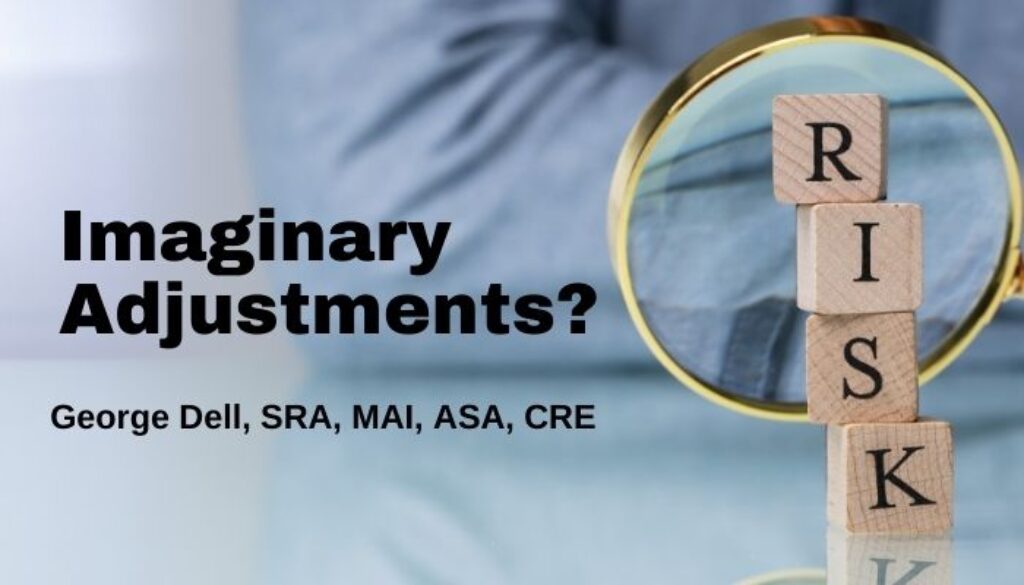You MUST make adjustments. Everybody knows that!
Or not.
In USPAP and The Appraisal of Real Estate (TARE) we have two predominant topical sources.
The USPAP standards do not require adjustments. The word “comparable” is not defined, nor is the word “adjustment” found in USPAP. Nothing about adjustments nor picking comps. However, we note that the USPAP Scope of Work Rule has the user expectations and peers’ actions test of “acceptability.” (Basically just do what everyone does, right or wrong.)
(As a side note, after much ado — the real property Standard 1 has only one word change in five years.)
The current official unofficial Advisory Opinions of the Foundation reference the 2018-2019 version of USPAP. While the word “adjustment” is used many times, there is no help on how to reckon an “appropriate adjustment.”
On the other hand, in TARE (Appraisal Institute), “adjust” or “adjustment” shows up 687 times – so it must be important. In particular it says use the words “extreme care,” and use only “truly comparable” comps, and always use “special care” in reckoning adjustment amounts. In spite of all this, there is no unified theory (nor algorithmic practice of adjustments).
There is however, a basic recognition as between quantitative and qualitative adjustment “support” methods. Quantitative methods are built on numbers, even as they are estimates, with very different and uncertain levels of reliability (precision). Qualitative methods are more subjective, but theoretically rely on ordered (non-parametric) preference. (Such as economists’ preference functions.)
Three basic quantitative methods are suggested in TARE: Paired data, grouped data, and secondary (third-party) data. We are warned to use “extreme care” because they are “difficult to apply,” and “could produce unreliable results” with narrow samples. It further states that secondary data analysis uses “data that does not directly pertain to the subject or comparable properties.”
Also statistical, trend analysis, graphs, cost, and income techniques are mentioned, without explanation as to how they are to be used. In each case we have admonishment that “special care must be taken.” (But what comprises “special care” is never defined.)
Qualitative methods include “relative comparison” – better or worse in judgment. Or, “ranking” analysis, which extends relative comparison to three or more judgments. “Personal interviews” is listed as a qualitative technique, with no support nor explanation on how this works.
So, there you have it! Just Eight pages out of seven hundred – “explain” carefulness in making adjustments. Apply an adjustment, then figure out how to “support” your adjustment. Be careful. Use extreme care. Use “truly comparable” comps. Not imaginary adjustments nor “special care adjustments.” (What are “regular” care adjustments?)
Why can’t we just calculate adjustments? Because. Again, we have rampant professional groupthink on how we wish things to be. Not how things actually are. Fiction versus truth. It’s a pretend game.
The search for professional truth (and public trust) lies in a simple, basic algorithm of human growth.
- Admit there is a problem.
- Come to believe a solution is possible.
- Decide to seek and pursue possible paths to truth.

August 30, 2023 @ 5:52 am
Residential appraisers making dollar-per-square foot site adjustments for minimal differences would be very hard to support ic court…
August 30, 2023 @ 9:42 am
I stopped making adjustments in most of my reports a long time ago. I put commentary in my report that I couldn’t find reliable data to extract an adjustment and that making an unsupported adjustment directly violates USPAP because it could create a misleading report. I get very little pushback from clients and that dies off quickly after I request in writing from the client that they want me to violate USPAP by making unsupported adjustments in the report.
September 1, 2023 @ 8:10 am
With the multitude of ways to determine market based adjustments, I’m very surprised to hear some appraisers don’t even make them. I think its easy to get lazy (and yes i’m guilty of this also) and declare there is not enough data to support an adjustment when in fact, you can typically find some adjustments within the very sales used in the report. The decision to make no adjustments should also be supported by market data
September 1, 2023 @ 11:09 am
The standard of practice for adjustment grids in a commercial report seems to be percentage adjustments based entirely on hunches, e.g. +20% for location. What attributes would justify 25% or 15%? Not explained. Is a quiet location superior to an arterial location? How do we know? Not explained. In practice, it’s an entirely circular process. The “right” adjustments are those adjustments that narrow the range of of adjusted sale prices, and that “proves” the process is correct, without reference to any objective fact. It’s nonsense.